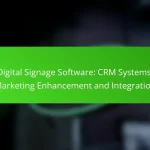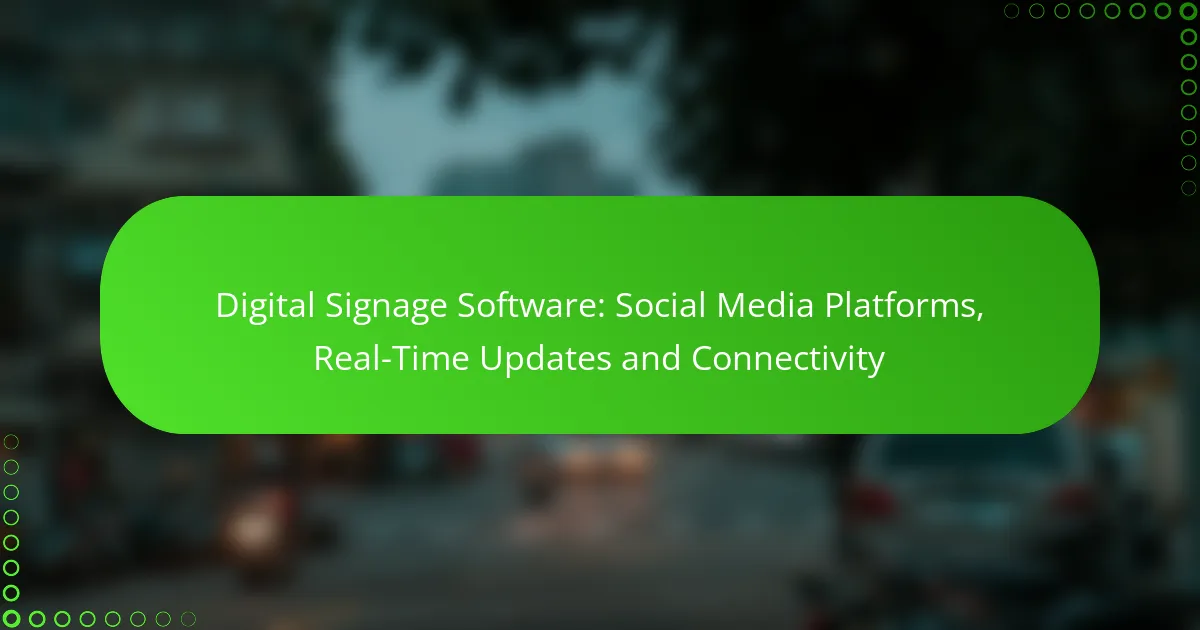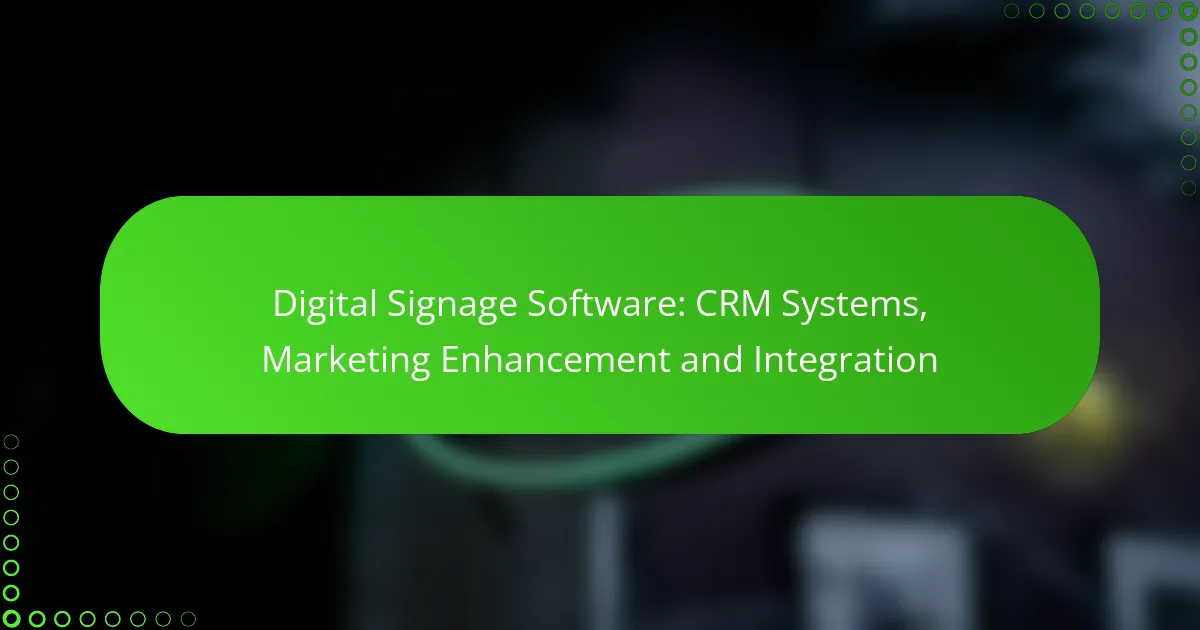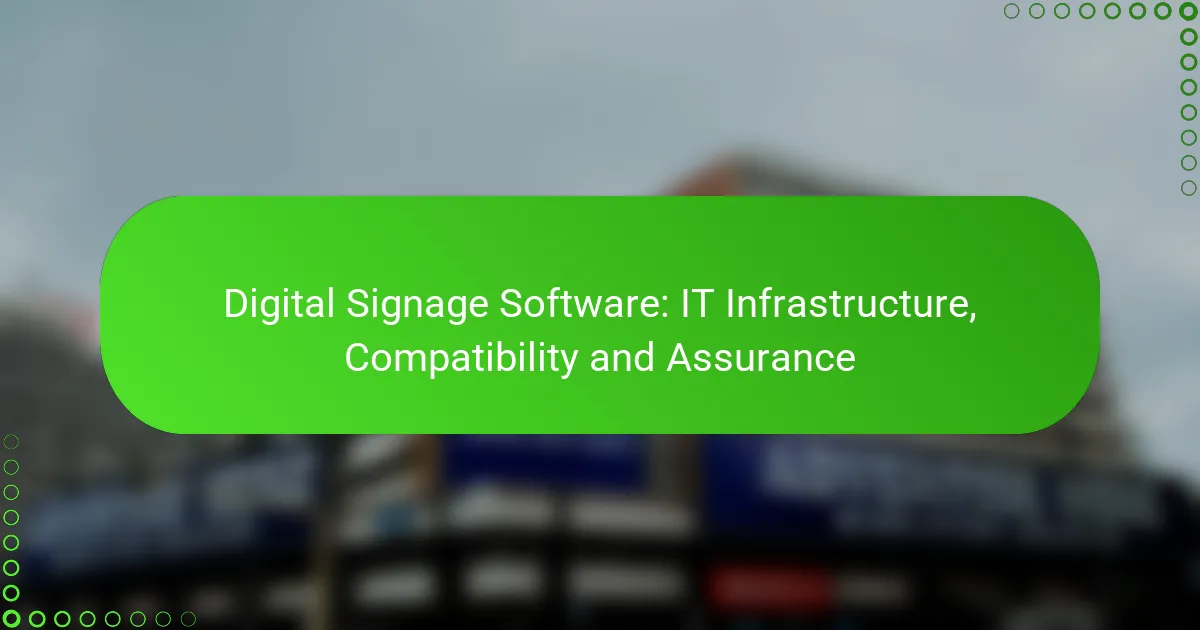Digital signage software has revolutionized the way businesses communicate with their audiences by seamlessly integrating social media platforms and providing real-time updates. With options like Scala Digital Signage and ScreenCloud, organizations can effectively manage content across multiple displays, ensuring that information remains current and engaging. This connectivity not only enhances audience interaction but also allows for quick responses to changing information, making digital signage a vital tool for modern communication strategies.
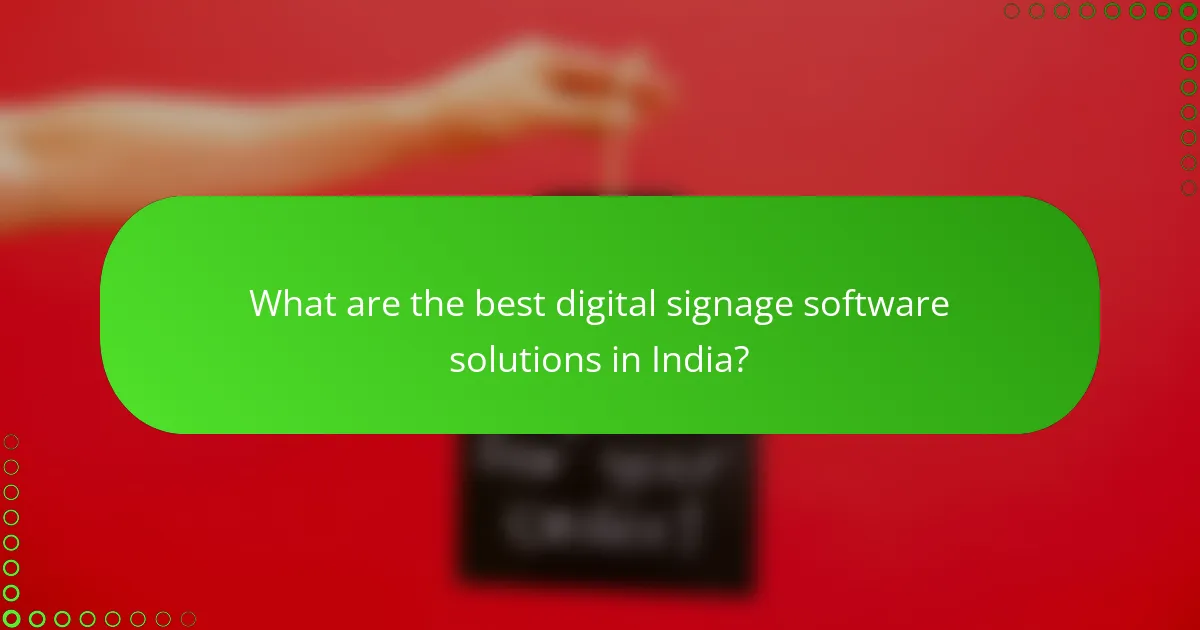
What are the best digital signage software solutions in India?
The best digital signage software solutions in India offer robust features for managing content across various displays, integrating social media, and providing real-time updates. Key options include Scala Digital Signage, ScreenCloud, Yodeck, Signagelive, and BrightSign, each catering to different business needs and budgets.
Scala Digital Signage
Scala Digital Signage is a comprehensive platform known for its flexibility and scalability. It allows users to create, manage, and distribute content across multiple screens, making it suitable for businesses of all sizes.
One of its standout features is the ability to integrate with various data sources, enabling real-time updates. This is particularly useful for retail environments where promotions can change frequently.
ScreenCloud
ScreenCloud is a user-friendly digital signage solution that emphasizes ease of use and quick deployment. It supports a wide range of content types, including images, videos, and social media feeds, making it versatile for various applications.
With its cloud-based architecture, ScreenCloud allows for remote management of displays, which is ideal for businesses with multiple locations. Pricing is typically subscription-based, making it accessible for small to medium enterprises.
Yodeck
Yodeck is a cost-effective digital signage solution that offers a simple interface for content management. It supports a variety of media formats and provides templates to streamline the design process.
One of its key advantages is the ability to schedule content in advance, allowing businesses to plan their displays according to specific times or events. Yodeck also offers a free trial, making it easy for users to test its features before committing.
Signagelive
Signagelive is a cloud-based platform that excels in its integration capabilities with third-party applications. This makes it suitable for businesses looking to leverage existing tools for enhanced functionality.
It offers a range of pricing plans, allowing businesses to choose based on their needs. Signagelive’s support for real-time data feeds is particularly beneficial for sectors like hospitality and retail, where timely information is crucial.
BrightSign
BrightSign is a hardware-centric digital signage solution that provides robust performance and reliability. It is often favored for its media players, which are designed to handle high-definition content seamlessly.
While it requires a more significant upfront investment compared to software-only solutions, BrightSign’s durability and extensive features make it a preferred choice for larger installations. Users should consider their specific hardware needs when opting for this solution.
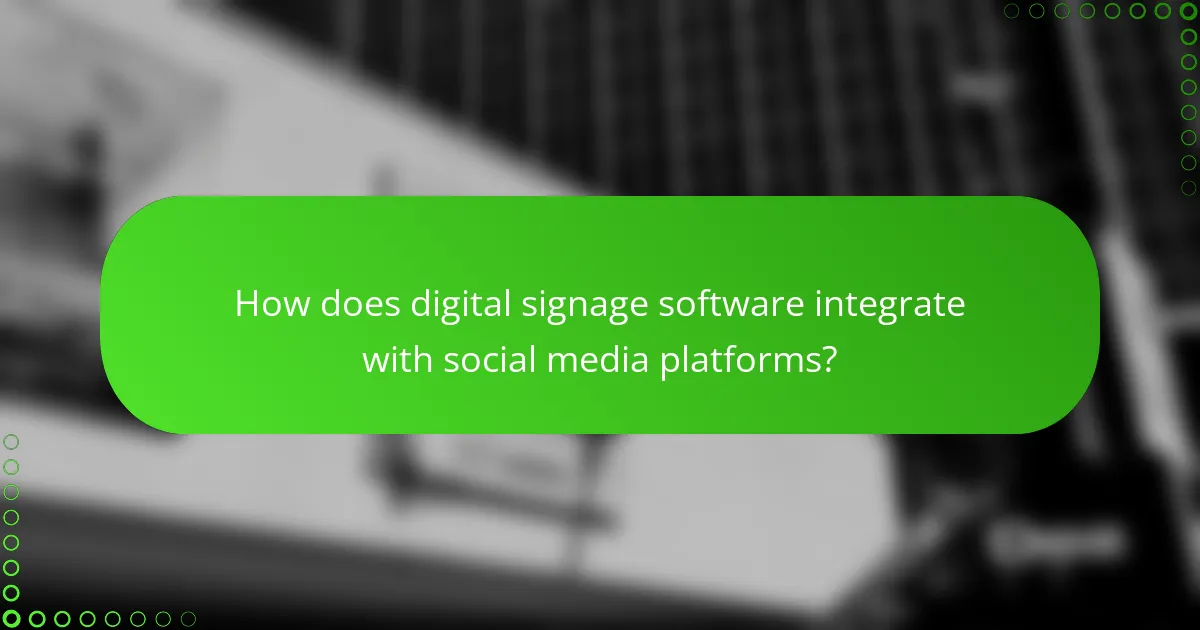
How does digital signage software integrate with social media platforms?
Digital signage software integrates with social media platforms by allowing users to display real-time updates and content directly from their social media feeds. This connectivity enhances audience engagement and ensures that displayed information is current and relevant.
Real-time content sharing
Real-time content sharing enables businesses to instantly broadcast updates from their social media accounts to digital signage displays. This feature is crucial for promoting timely events, special offers, or breaking news, keeping viewers informed and engaged. For example, a restaurant can share live updates about daily specials or menu changes directly on their signage.
Social media feeds integration
Integrating social media feeds into digital signage allows for a dynamic display of user-generated content, such as tweets, Instagram posts, or Facebook updates. This integration can create a more interactive experience by showcasing customer interactions and testimonials. Businesses should ensure that the content displayed aligns with their brand image and messaging to maintain consistency.
Content scheduling tools
Content scheduling tools within digital signage software enable users to plan and automate the display of social media content at specific times. This feature is particularly useful for businesses that want to optimize viewer engagement during peak hours. For instance, a retail store might schedule promotional posts to appear during busy shopping periods, maximizing visibility and impact.
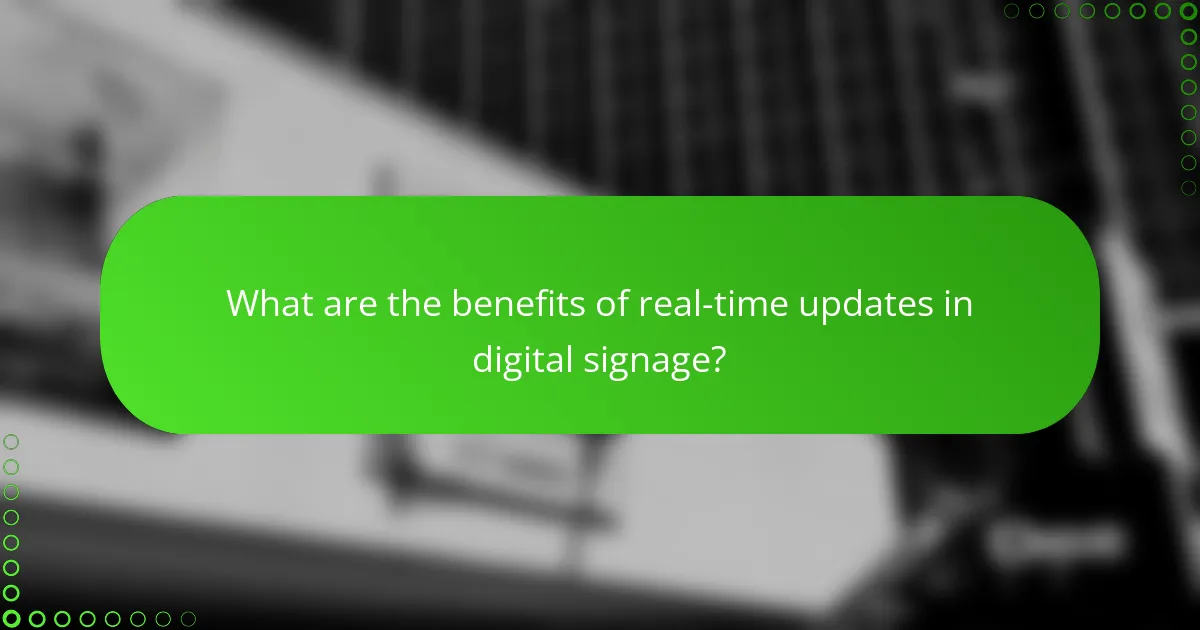
What are the benefits of real-time updates in digital signage?
Real-time updates in digital signage enhance communication by providing current information and engaging content. This capability allows businesses to respond quickly to changes, ensuring that the displayed information is relevant and timely.
Improved audience engagement
Real-time updates significantly boost audience engagement by delivering fresh and relevant content. For instance, a restaurant can showcase daily specials or limited-time offers, capturing the attention of passersby and encouraging immediate visits.
Interactive elements, such as social media feeds or live polls, can further enhance engagement. By integrating these features, businesses can create a dynamic viewing experience that encourages audience participation and interaction.
Timely information delivery
Timely information delivery is crucial for keeping audiences informed about events, promotions, or emergencies. Digital signage can instantly relay updates, such as changes in event schedules or urgent alerts, ensuring that viewers receive critical information without delay.
For example, a transportation hub can display real-time updates on train or bus schedules, allowing travelers to make informed decisions quickly. This immediacy helps reduce confusion and enhances overall customer satisfaction.
Dynamic content management
Dynamic content management allows businesses to easily update and manage their digital signage content from a centralized platform. This flexibility enables quick changes to be made based on audience feedback or external factors, such as weather conditions or market trends.
Utilizing cloud-based software can streamline this process, allowing for remote updates and scheduling. Companies can automate content changes, ensuring that their messaging remains fresh and aligned with current events or promotions.

What connectivity options are available for digital signage software?
Digital signage software can connect through various options, including Wi-Fi, Ethernet, and cloud-based solutions. Each connectivity method has its own advantages and considerations, impacting performance, reliability, and ease of use.
Wi-Fi connectivity
Wi-Fi connectivity allows digital signage systems to connect wirelessly to the internet, making installation flexible and reducing cable clutter. This option is ideal for locations where running Ethernet cables is impractical or too costly.
However, Wi-Fi can be less reliable than wired connections, especially in areas with high interference or weak signals. It’s essential to ensure a strong Wi-Fi signal and consider using Wi-Fi extenders if necessary.
Ethernet connections
Ethernet connections provide a stable and secure way to connect digital signage systems directly to the internet via cables. This method is often preferred for its reliability and faster data transfer rates, making it suitable for high-resolution content.
While Ethernet installations may require more effort and cost upfront due to cabling, they typically offer lower latency and are less susceptible to interference compared to Wi-Fi. Businesses should evaluate their layout and future scalability when choosing this option.
Cloud-based solutions
Cloud-based solutions enable digital signage software to operate over the internet, allowing for easy updates and management from anywhere. This approach is particularly beneficial for businesses with multiple locations, as it centralizes content management.
While cloud solutions offer flexibility and scalability, they depend on a reliable internet connection. Businesses should assess their internet bandwidth and consider backup options to ensure continuous operation, especially in critical environments.

What criteria should be considered when choosing digital signage software?
When selecting digital signage software, consider factors such as scalability, user interface, and cost-effectiveness. These criteria will help ensure that the software meets your current needs and can adapt as your requirements evolve.
Scalability
Scalability refers to the software’s ability to grow with your business. A scalable solution should accommodate an increasing number of displays, users, and content types without significant performance degradation.
Look for software that allows you to easily add or remove screens and manage them from a centralized platform. This flexibility is crucial for businesses that may expand or change locations over time.
User interface
The user interface (UI) should be intuitive and user-friendly to ensure that team members can operate it without extensive training. A well-designed UI allows for easy navigation, quick content updates, and efficient management of multiple displays.
Consider testing the software with a demo or trial version to assess its usability. A clean, organized layout can significantly reduce the time spent on content management and updates.
Cost-effectiveness
Cost-effectiveness involves evaluating the software’s pricing structure in relation to its features and benefits. Look for options that provide a good balance between affordability and functionality, ensuring you get value for your investment.
Consider both upfront costs and ongoing expenses, such as subscription fees or maintenance charges. It’s wise to compare multiple software solutions to identify the best fit for your budget while meeting your digital signage needs.
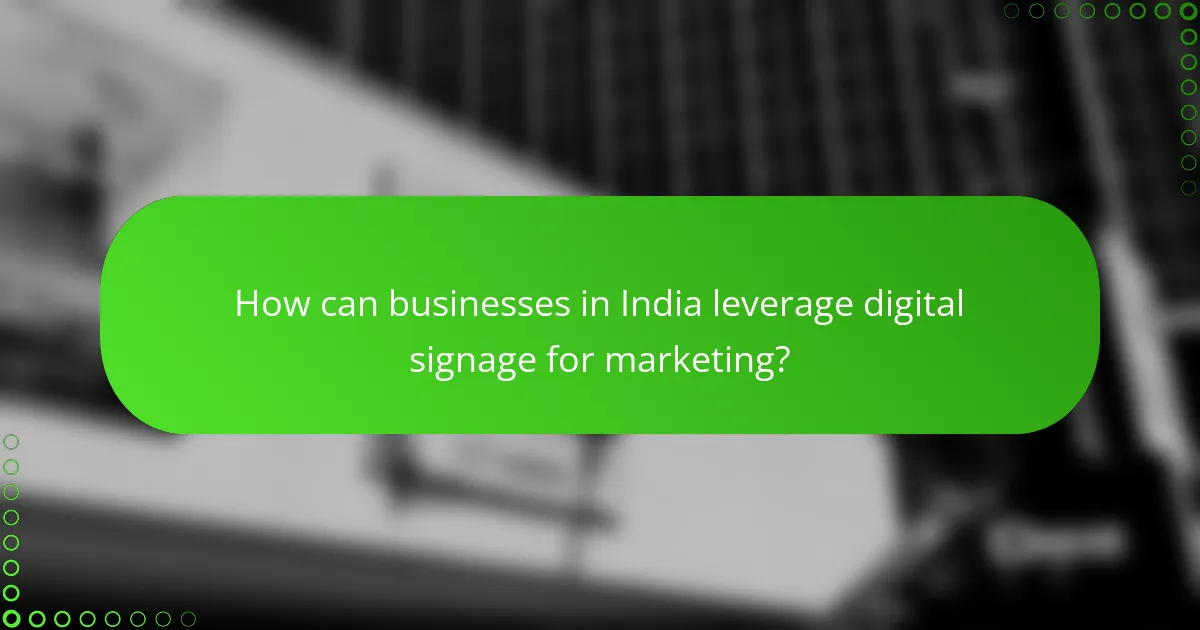
How can businesses in India leverage digital signage for marketing?
Businesses in India can effectively use digital signage to enhance their marketing strategies by displaying dynamic content that captures customer attention. This technology allows for real-time updates and integration with social media platforms, making it a versatile tool for engaging audiences.
Utilizing social media platforms
Integrating social media platforms with digital signage enables businesses to showcase user-generated content, promotions, and live feeds. This approach not only increases engagement but also builds community by encouraging customers to interact with the brand online.
For instance, a retail store can display Instagram posts featuring customers using their products, creating a sense of authenticity. Businesses should consider using hashtags to encourage customers to share their experiences, which can then be featured on digital displays.
Implementing real-time updates
Real-time updates are crucial for keeping content fresh and relevant. Businesses can use digital signage to display live information such as sales, event announcements, or even news that resonates with their target audience.
For example, a restaurant can update its menu items or special offers instantly, ensuring customers are always informed. It’s important to have a reliable content management system that allows for quick changes to avoid outdated information being displayed.
Ensuring connectivity
Connectivity is essential for effective digital signage. Businesses should ensure their displays are connected to the internet for seamless updates and integration with other platforms. This connectivity allows for remote management of content, which can save time and resources.
When choosing a digital signage solution, consider options that offer cloud-based management systems. This enables easy access and control over content from anywhere, making it easier to adapt to changing marketing needs. Additionally, ensure that the network infrastructure is robust to support high-quality content delivery without interruptions.

